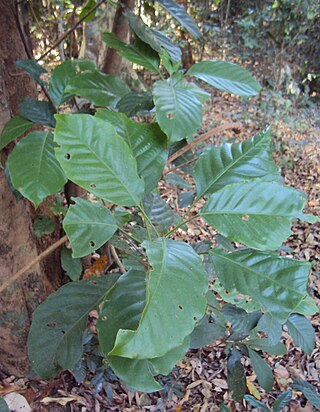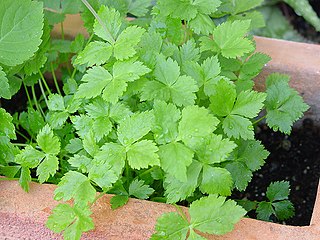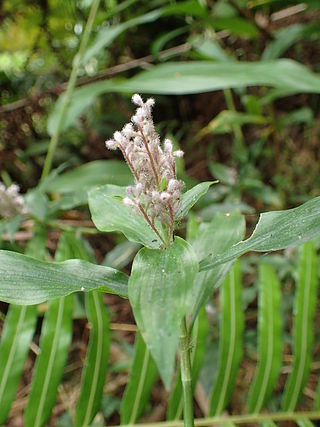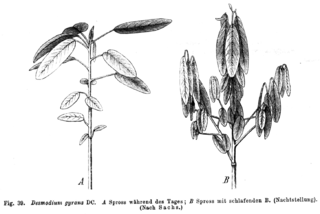
Olea is a genus of flowering plants in the family Oleaceae. It includes 12 species native to warm temperate and tropical regions of the Middle East, southern Europe, Africa, southern Asia, and Australasia. They are evergreen trees and shrubs, with small, opposite, entire leaves. The fruit is a drupe. Leaves of Olea contain trichosclereids.

Paracroton is a genus of flowering plants in the Euphorbiaceae first described as a genus in 1859. It is native to South and Southeast Asia, as well as New Guinea.
- Paracroton integrifolius(Airy Shaw) N.P.Balakr. & Chakr. - Kerala, Tamil Nadu
- Paracroton pendulus(Hassk.) Miq. - India, Sri Lanka, Myanmar, Thailand, Malaysia, Borneo, Sumatra, Philippines
- Paracroton sterrhopodus(Airy Shaw) Radcl.-Sm. & Govaerts - W New Guinea
- Paracroton zeylanicus(Müll.Arg.) N.P.Balakr. & Chakr. - Sri Lanka
Spathiostemon is a genus of trees in the Euphorbiaceae family. It is native to the Bismarck Archipelago, New Guinea, Wallacea and Southeast Asia. The trees grow between 10 and 20m tall, often in secondary forest. The wood is sometimes used.

Koilodepas is a genus of plant of the family Euphorbiaceae first described as a genus in 1856. It is native to Southeast Asia, India, Hainan, and New Guinea.

Cryptotaenia, or honewort, is a genus of herbaceous perennial plants, native to North America, Africa, and eastern Asia, growing wild in moist, shady places.
Pimelodendron is a plant genus in the family Euphorbiaceae first described as a genus in 1855. It is native to insular Southeast Asia, Thailand, Papuasia, and Queensland.

Cyanotis is a genus of mainly perennial plants in the family Commelinaceae, first described in 1825. Species of the genus are native to Africa, southern Asia, and northern Australia.

Barringtonia is a genus of flowering plants in the family Lecythidaceae first described as a genus with this name in 1775. It is native to Africa, southern Asia, Australia, and various islands of the Pacific and Indian Oceans. The genus name commemorates Daines Barrington.

Floscopa is a genus of plants in the family Commelinaceae first described in 1790. It is widespread in tropical and subtropical areas: Africa, Madagascar, the Indian Subcontinent, Southeast Asia, China, Queensland, Central + South America.

Cardiopteridaceae is a eudicot family of flowering plants. It consists of about 43 species of trees, shrubs, and woody vines, mostly of the tropics, but with a few in temperate regions. It contains six genera, the largest of which is Citronella, with 21 species. The other genera are much smaller.

Codariocalyx is a genus of flowering plants in the legume family, Fabaceae. It belongs to subfamily Faboideae. The genus contains two species which range from the Indian Subcontinent, Tibet, Indochina, southern China, Malesia, and New Guinea.

Justus Carl Hasskarl was a German explorer and botanist specializing in pteridophytes, bryophytes and spermatophytes.

Murdannia is a genus of annual or perennial monocotyledonous flowering plants in the family Commelinaceae.

Amischotolype is a genus of perennial monocotyledonous flowering plants in the Commelinaceae. It is found in Central Africa and from India through Southeast Asia to New Guinea, with the great majority or species found in Asia.

Blyxa is a genus of an aquatic plant of the family Hydrocharitaceae described as a genus in 1806.

Belosynapsis is a genus of mainly perennial plants in the family Commelinaceae, first described in 1871. It is native to Southeast Asia, the Indian Subcontinent, Papuasia, and southern China.
Pimelodendron amboinicum is a tree species in the Euphorbiaceae family. It is found from the Solomon Islands in the southwest Pacific, west to Sulawesi in Indonesia. The timber is used locally, though larger-scale illegal logging is apparent.
Maasia is a genus of flowering plants belonging to the family Annonaceae.
Tetragonocarpus teysmannii is a species of flowering plant in the dogbane family, Apocynaceae. It is the sole species in genus Tetragonocarpus. It is a climbing subshrub or shrub native to Java and the Lesser Sunda Islands.













